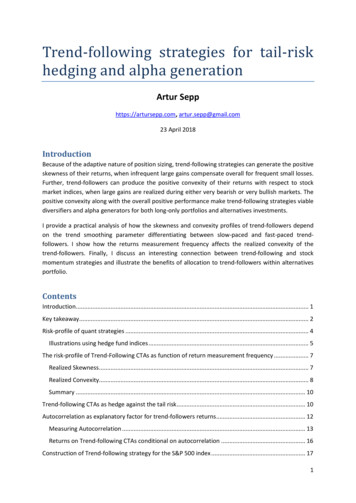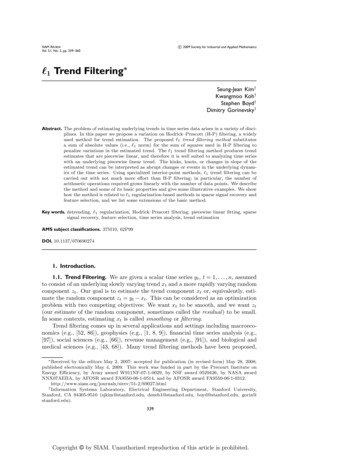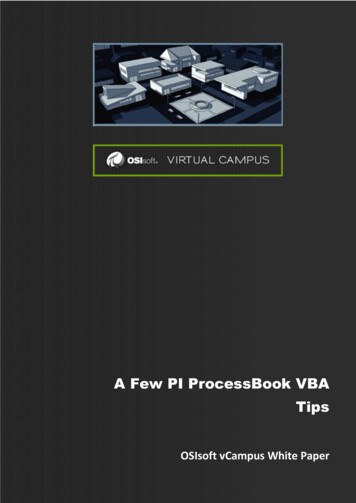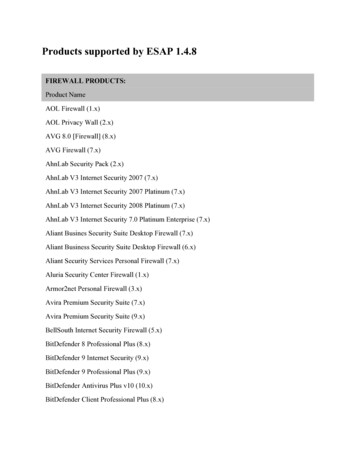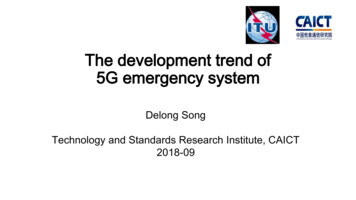
Transcription
The development trend of5G emergency systemDelong SongTechnology and Standards Research Institute, CAICT2018-09
Course Objectives:Introducing the development of emergency system technology andstandard, the progress of emergency technology and industry in China,and the application situation in other countries.
Contents emergency system Summary International emergency system technologyand standard emergency system Standards in China
Four “legs” of emergencycommunications citizen-to-citizen citizen-to-government government-to-citizen government-to-government
Four “legs” of emergencycommunications citizen-to-citizen - An individual communicating an emergency toanother individual or private organization via available options. citizen-to-government - An individual communicating an emergencymessage to appropriate authorities via available options. government-to-citizen - Government or authorized officialscommunicating alerts or details of an emergency to individuals andorganizations via available options. government-to-government - includes governmental authoritiescommunicating to each other, other agencies, and appropriateNational Security/Emergency Preparedness (NS/EP)-designated privateindustry concerns and coordinators.
Global public safety spectrum planning
Contents emergency system Summary International emergency system technologyand standard emergency system Standards in China
What is MCPTT MCPTT--Mission critical push to talk MCPTT new global standard, which will replace legacy groupcommunication systems, such as VHF, TETRA, P25, iDEN andothers. Features Group communication system enablers for LTE-GCSEIsolated E-UTRAN operation for public safety(IOPS)Proximity service a.k.a prose , LTE-D,direct mode ,D2DEnhanced bearer assignment (QCI values)
Who specified and support MCPTT FirstNet NPSTC The United Kingdom Home Office TCCA APCO TIA OMA ETSI
Who are MCPTT usersMCPTT market (users) comprises from several sectors:
Technology migration
Main PlayersE2E work of MissionCritical eratorsLegacyTetra Vendor
3GPP MCPTT architectureTerminal domainEPS bear domainApplicationdomainSIP core domainGC1 overPC5RelayGC1 SSMCPTT serverMCPTTuserdatabaseRxPCRFUEFloor controlserverS6aSig/Mediaover PC5GxMMEPC5Common service coreS- 11S1- MMEApplica-tionclientA3S/P-GWSmM3SGiUuE- UTRANS1-uM1MBMS- GWSGimbSGmbGC1GMSA4A1 A2 KMS
Architecture MCPTT server Call control Floor control Media handling Common server core Other MCPTTserverMCPTT userdatabaseMCPTT-3MCPTT-2MCPTT serverMCPTT TT clientMCPTT-7MediamixerMCPTT-8Interworkingfunction tolegacy systemIWF-1MCPTT-1FloorcontrolserverGroup managementIdentity managementConfig managementKey managementCSC-5Other ces coreFunctional model for application planeEPS
ArchitectureTo otherSIP core SIP core compliant with IMS core; orsimplified IMS core Local proxyRegistrationService selectionSecurity of SIP signalingSIP-3SIPdatabaseMCPTT UEAAA-1Registrarfinder/I-CSCFMCPTT serverSIP-2SIP ASHTTPserverHTTPclientLocal proxy/P-CSCFSIP-1SIP ASSignallinguser agentRegistrarAS selection/S-CSCFSIP coreHTTP-2HTTP-1HTTPProxyHTTP-1HTTP-2HTTP serverRxHTTP clientEPSHTTP-3To otherHTTPproxyCommonservices coreFunctional model for signalling control plane
FunctionalitiesUE BootUE configuration (initial)MCPTT AuthorizationUE configurationUser configuration (including user profile)Group configurationMCPTT operation(s)(e.g., Affiliation,Call establishment,Ongoing call,Call release)Updates to:UE configuration, User configuration, GroupconfigurationMCPTT log-offMCPTT service life circle
3GPP specifications status
Technical Requirement for 3GPP 1. Various media such as conversational type communication (e.g. voice,video) or streaming (e.g. video) or data (e.g. messaging) or a combination of them. 2. Group Communication end-to-end setup time less than or equal to300ms. 3. Service continuity. 4. The number of Receiver Group Members is unlimited. 5. Security level for Group Communication. 6. Roaming and network interworking. 7. Charging. 8. High availability of Group Communication.
Or why should I be interested? Quality: MCPTT offer good audio and global coveragefrom day one. Requirements for MCPTT are set bygovernments and public-safety organization, but sametechnology is available also for commercial users. Availability: MCPTT service and devices are availablemultiple vendors. Single-supplier blackmailing wontwork anymore. CAPEX: Investments to start using MCPTT is low,consisting only from device (phone) costs. OPEX: Usage cost per user is small compared to VHF,TETRA, P25, iDEN or other legacy systems
Release 12 (completed)1. GCSE: Group communication systemenabler a. MBMS and EPS bearerb. New QCIc. Services Continuityd. Priority and Pre-emption for GroupCommunication e. Charging f. Security2. ProSe
Group communication systemenabler for LTE
ProSe
Rel-13 MCPTT (completed 2016) User authentication and service authorization Configuration Affiliation and de-affiliation Group calls on-network and off-network (within one system or multiple systems, pre-arranged or chat model, late entry, broadcastgroup calls, emergency group calls, imminent peril group calls, emergency alerts) Private calls on-network and off-network (automatic or manual commencement modes, emergency private calls) MCPTT security Encryption (media and control signalling) Simultaneous sessions for call Dynamic group management (group regrouping) Floor control in on-network (within one system or across systems) and in off-network Pre-established sessions Resource management (unicast, multicast, modification, shared priority) Multicast/Unicast bearer control, MBMS (Multimedia Broadcast/Multicast Service) bearers Location configuration, reporting and triggering Use of UE-to-network relays
MCPTT Key Features
Rel-14 MC Services (completed 2017)1.2.3.4.MC Services Common FunctionalitiesMCPTT EnhancementsMCVideo, Common Functions plusMCData, Common Functions plus
1.MC Services Common Functionalities User authentication and service authorization Service configuration Affiliation and de-affiliation Extended Location Features (Dynamic) Group Management Identity management MC Security framework Encryption (media and control signalling)
2.MCPTT Enhancements First-to-answer call setup (with and without floor control) Floor control for audio cut-in enabled group Updating the selected MC Service user profile for an MC Service Ambient listening call MCPTT private call-back request Remote change of selected group
3.MCVideo, Common Functions plus Group Call (including emergency group calls, imminent perilgroup calls, emergency alerts) Private Call (off-network) Transmission Control
4.MCData, Common Functions plus MCData, Common Functions plus: Short Data Service (SDS) File Distribution (FD) (on-network) Transmission and Reception Control Handling of Disposition Notifications Communication Release
MCVideo usage scenarios 1. Car Bombing Incident 2. Remote Monitoring of a Road Traffic Stop 3. MCVideo Pursuit scenario 4. Hostage Incident 5. Train Crash and Fire 6. Investigation of Police Officers
MCData services suiteMCData services suite includes the following: - short data service (messaging); - file distribution; - data streaming; - conversation management; - transmission and reception control; and - enhanced status.
Rel-15 MC Services (in progress) MC Services Common Functionalities Enhancements MCPTT Enhancements MCVideo Additions MCData Additions
MC Services Common FunctionalitiesEnhancements Enhanced MCPTT group callsetup procedure with MBMSbearer Enhanced Location management,information and triggers Interconnection between 3GPPdefined MC systems Interworking with legacysystems
MCPTT Enhancements Remotely initiated MCPTT call Enhanced handling of MCPTT Emergency Alerts Enhanced Broadcast group call Updating pre-selected MC Service user profile Temporary group call - user regroup Functional alias identity for user and equipment Multiple simultaneous users
MCVideo Additions Video push Video pull Private call (on-network) Broadcast Group Call Ambient Viewing Call Capability information sharing Simultaneous Sessions Use of MBMS transmission Emergency and imminent peril private communications Primary and Partner MC system interactions for MCVideo communications Remote video parameters control capabilities
MCData Additions MCData specific Location Enhanced Status Accessing list of deferred communications Usage of MBMS Emergency Alert Data streaming File Distribution (FD) (off-network) IP connectivity
Timeline for MC Services and 3GPP Releases Release 13 Mission Critical Push to Talk (MCPTT) completed in March 2016 Release 14 MCPTT Improvements completion 09/2017 MCData completion 09/2017 MCVideo completion 09/2017 Release 15 and beyond MCPTT Improvements completion 06/2018 MCData completion 06/2018 MCVideo completion 06/2018 Railways (FRMCS) study ongoing in SA6,normative work completion 06/2018 Interconnection between systems study completed,normative work completion 06/2018 Interworking with legacy systems study completed,normative work completion 06/2018 Maritime communications study ongoing in SA1 Railways (FRMCS2) study and normative work ongoing in SA1 MBMS APIs for MC Services study ongoing in SA6
3GPP Mission Critical Specifications Stage 1 – Requirements Stage 2 – Functional Architecture and Procedures Stage 3 – Protocols Conformance Testing (so far only for Rel-13 MCPTT)
Stage 1 – Requirements TS 22.280 - MCS Common Requirements TS 22.179 - MCPTT over LTE requirements TS 22.281 - MCVideo over LTE requirements TS 22.282 - MCData over LTE requirements TS 22.289 – Mobile Communication Systems forRailways TR 22.819 - Study on Maritime CommunicationServices over 3GPP system
Stage 2 – Functional Architecture andProcedures TS 23.280 – MC Common Architecture TS 23.379 – MCPTT Architecture and Flows TS 23.281 – MCVideo Architecture and Flows TS 23.282 – MCData Architecture and Flows TS 33.180 – MC Services Security aspects TS 23.283 – MC Interworking between LTE-based systems andnon-LTE-based systems TR 23.790 - Study on application architecture for the FutureRailway Mobile Communication System (FRMCS)
Stage 3 – Protocols TS 24.379 – MCPTT Call Control TS 24.380 – MCPTT Media Plane TS 24.481 – MCS Group Management TS 24.482 – MCS Identity Management TS 24.483 – MCS Management Object (MO) TS 24.484 – MCS Configuration Management TS 24.281 – MCVideo signalling protocol TS 24.581 – MCVideo media plane control TS 24.282 – MCData signalling protocol TS 24.582 – MCData media plane control TR 24.980 - Minimum requirements for support of MCPTT over the Gm
Conformance Testing(so far only for Rel-13 MCPTT) TS 36.579-1 Mission Critical Push To Talk (MCPTT) over LTE; Part 1:Common test environment TS 36.579-2 Mission Critical Push To Talk (MCPTT) over LTE; Part 2: UserEquipment (UE) Protocol conformance specification TS 36.579-3 Mission Critical Push To Talk (MCPTT) over LTE; Part 3: MCPTTServer Application conformance specification TS 36.579-4 Mission Critical Push To Talk (MCPTT) over LTE; Part 4: TestApplicability and Implementation Conformance Statement (ICS) proformaspecification TS 36.579-5 Mission Critical Push To Talk (MCPTT) over LTE; Part 5:Abstract test suite (ATS)
3GPP organization �组
FRMCS Scenarios 1:Interworking scenarios of private call MCPTT UE A initiates a private call to GSM-R UE BMCPTTUE AMCPTT System AGSM-R System BGSM-RUE B GSM-R UE B initiates a private call to MCPTT UE AMCPTTUE AMCPTT System AGSM-R System BGSM-RUE B
FRMCS Scenarios 2:Interworking scenarios for group calls Group call for groups defined by the MCPTT systemMCPTTUE AMCPTT System AMCPTT OtherUEsGSM-R System BGSM-R OtherUEs Emergency group call for groups defined by the MCPTT systemMCPTTUE AMCPTT System AMCPTT OtherUEsGSM-R System BGSM-R OtherUEs
FRMCS Scenarios 3:Interworking scenarios for location services MCPTT system obtains and shares the location information of GsM-R UEsMCPTTUE AMCPTT System AGSM-R System BGSM-RUE BMCPTT OtherUEs GSM-R system obtains and shares the location information of McPTT UEsMCPTTUE AMCPTT System AGSM-R System BGSM-R OtherUEsGSM-RUE B
Contents emergency system Summary International emergency system technologyand standard emergency system Standards in China
CCSA organization structureCommittee(TC5) is responsiblefor B-TrunC standards .
CCSA TC5 (Wireless Communication )B-TrunC Standardization Technical requirements for interface Technical requirements for equipments Test methods for interface Test methods for equipments
ApplyelectricityPublic Safetyrailwayemergencymetroports and airporsGovernment
Quiz questions:1. Which organization completes MCPTT standards:A. 3GPP B. 3GPP2 C.IEEE D.CCSA2. Which organization completes B-TrunC standards:A. 3GPP B. 3GPP2 C.IEEE D.CCSA3.What is the frequency of B-TrunC: A.1.4GHz B.700MHz C.1.8GHz4. Group Communication end-to-end setup time less than or equal to 300ms.5. The government network operator for the public safety community in the United States.Assignment:1.What is the most critical issue for the emergency system?2.Please list 3 application scenarios for emergency communication.Answer:1. A 2. D 3.AC 4.T 5.T
(Trainer information)Trainer: Delong SongE-mail: songdelong@caict.ac.cnDepartment: Institute of Technology and Standard Research, CAICTAddress: No.52 Huayuan Bei Road, Haidian District, Beijing, P.R.ChinaPhoto:
Thank you for your attention中国信息通信研究院 http://www.caict.ac.cn
Technology and Standards Research Institute, CAICT 2018-09. Course Objectives: . MCPTT--Mission critical push to talk MCPTT new global standard, which will replace legacy group communication systems, such as VHF, TETRA, P25, iDEN and others. Features





